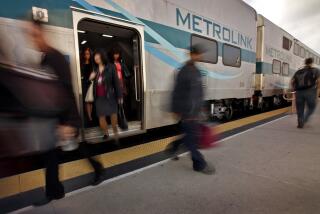Metrolink Must Re-Emphasize Safety : Train Service Expands After Quake, but Old Dangers Remain for Drivers and Pedestrians
- Share via
The earthquake-inspired effort to rush more Metrolink commuter train lines and stations into service is a vitally important step that might help the Los Angeles County transportation system become far more versatile and efficient. But with new and more frequent service rolling out of Lancaster, Palmdale, Santa Clarita, Canyon Country, Sylmar and other locations, it is equally important to remember that the public must be reacquainted and educated about the easily avoidable dangers trains present to motorists and pedestrians.
The dangers should be obvious, but the frequency of carnage and death along the Metrolink lines suggests otherwise, particularly in the San Fernando Valley. In North Hollywood in December, a teen-age boy was struck and killed by a Metrolink train as he walked along the tracks while listening to music on a headset. In Sunland earlier this month, a boy on his bicycle ignored a train’s warning signals, rode around lowered crossing gates and was killed.
That last fatality occurred eight miles south of a stretch of track where four lives were lost in only an eight-month period. We note here also that statistics from the national nonprofit public education program called Operation Lifesaver show California with the nation’s highest percentage of motorist crashes at railroad crossings with active warning devices--exactly the type of crossing that ought to be accident-free.
Because of such statistics, it is incumbent upon Metrolink officials to conduct the same kind of public information campaigns that it has in the past in response to high numbers of citations and accidents. A certain amount of common sense on the part of citizens is also in order.
It simply never makes sense for a motorist, for example, to attempt to beat a Metrolink train to a crossing. These are quick, short trains and the delays created by their passage are minimal at most. Pedestrians also need to remember that a train traveling at just 59 m.p.h. will cover 100 yards in less than 3 1/2 seconds. A railroad track is one of the last places where caution and attentiveness should be cast to the wind.
More to Read
Sign up for Essential California
The most important California stories and recommendations in your inbox every morning.
You may occasionally receive promotional content from the Los Angeles Times.









